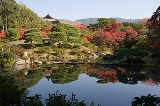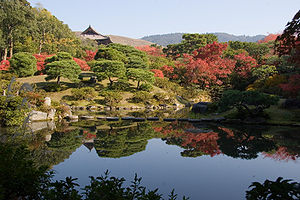
Isuien Garden
Encyclopedia



Japanese garden
, that is, gardens in traditional Japanese style, can be found at private homes, in neighborhood or city parks, and at historical landmarks such as Buddhist temples, Shinto shrines and old castles....
located in Nara
Nara, Nara
is the capital city of Nara Prefecture in the Kansai region of Japan. The city occupies the northern part of Nara Prefecture, directly bordering Kyoto Prefecture...
, the old capital of Japan
Japan
Japan is an island nation in East Asia. Located in the Pacific Ocean, it lies to the east of the Sea of Japan, China, North Korea, South Korea and Russia, stretching from the Sea of Okhotsk in the north to the East China Sea and Taiwan in the south...
near to Kyōto
Kyoto
is a city in the central part of the island of Honshū, Japan. It has a population close to 1.5 million. Formerly the imperial capital of Japan, it is now the capital of Kyoto Prefecture, as well as a major part of the Osaka-Kobe-Kyoto metropolitan area.-History:...
. It has been preserved since its creation in the Meiji era, and is the only walking garden (' ' kaiyushiki teien' ') in Nara. It is divided into two sections (which were originally two separate gardens) that each feature a pagoda
Pagoda
A pagoda is the general term in the English language for a tiered tower with multiple eaves common in Nepal, India, China, Japan, Korea, Vietnam and other parts of Asia. Some pagodas are used as Taoist houses of worship. Most pagodas were built to have a religious function, most commonly Buddhist,...
. The gardens cover roughly 145000 square feet (13,470.9 m²).
In 1939, the two gardens were bought and combined by Jyunsaku Nakamura, a merchant of Nara, in order to provide a site for the attached Neiraku museum (寧楽美術館), which hosts a collection of traditional Japanese ceramics.
History
The garden site original formed part of Manishu-in, a minor temple which was part of the larger temple Kofuku-jiKofuku-ji
is a Buddhist temple in the city of Nara, Nara Prefecture, Japan. The temple is the national headquarters of the Hossō school and is one of the eight Historic Monuments of Ancient Nara inscribed on the UNESCO World Heritage List.-History:...
. The ground was bought in the 1670, during the Enpō era by Michikiyo Kiyosumi, a wealthy tanner. Michikiyo restructured the gardens and built two pavilians: Sanshutei and Teishuken. These were built with a thatched roof. The name Sanshutei (“house of the three wonders”) was given by Mokuan, the large priest of the Manpuku-ji temple of l' school Zen Oubaku with Uji.
Layout
In the central pond of the gardens, there are two islands with sculptures of a craneCrane (bird)
Cranes are a family, Gruidae, of large, long-legged and long-necked birds in the order Gruiformes. There are fifteen species of crane in four genera. Unlike the similar-looking but unrelated herons, cranes fly with necks outstretched, not pulled back...
and tortoise
Tortoise
Tortoises are a family of land-dwelling reptiles of the order of turtles . Like their marine cousins, the sea turtles, tortoises are shielded from predators by a shell. The top part of the shell is the carapace, the underside is the plastron, and the two are connected by the bridge. The tortoise...
. These are animals which in Japanese culture represent longevity. The back gardens were completed in 1899 by Tojiro Seki, a Nara businessman. Tojiro hired for the redesign Horitoku, a garden architect from the school of Urasenke
Urasenke
is the name of one of the main schools of Japanese tea ceremony. It is one of the san-Senke ; the other two are Omotesenke and Mushakōjisenke....
.
The house of the Hyoshintei, along with the west pool, were designed by Kimura Seibei, another garden architect from Urasenke. It allows access of the house by using a technique called shakkei, or "borrowed landcape." The composition of the landscape incorporates the roof of the large southern door (Nandaimon) of the temple Tōdai-ji
Todai-ji
, is a Buddhist temple complex located in the city of Nara, Japan. Its Great Buddha Hall , the largest wooden building in the world, houses the world's largest bronze statue of the Buddha Vairocana, known in Japanese simply as Daibutsu . The temple also serves as the Japanese headquarters of the ...
, as well as the three higher hills overhanging Nara: the mounts Wakakusa, Kasuga, and Mikasa. It is framed by the trees of the Himuro sanctuary in the south, and the Tōdai-ji temple in the north. These make the space between the garden and background seem to disappear, producing a continuity which makes the landscape blend in visual harmony. This harmony is reinforced by the absence of any artificial enclosure.
The pond itself represents it kanji
Kanji
Kanji are the adopted logographic Chinese characters hanzi that are used in the modern Japanese writing system along with hiragana , katakana , Indo Arabic numerals, and the occasional use of the Latin alphabet...
水 (' ' mizu' ' , “water”). A central island is connected to bank by a series of stepping stones, which were formerly used to grind the pigments used in dyeing
Dyeing
Dyeing is the process of adding color to textile products like fibers, yarns, and fabrics. Dyeing is normally done in a special solution containing dyes and particular chemical material. After dyeing, dye molecules have uncut Chemical bond with fiber molecules. The temperature and time controlling...
. The garden also contains decorative stones, which were popular during the Meiji era. The water is fed by the Yosiki river, which flows adjacent to the garden.

